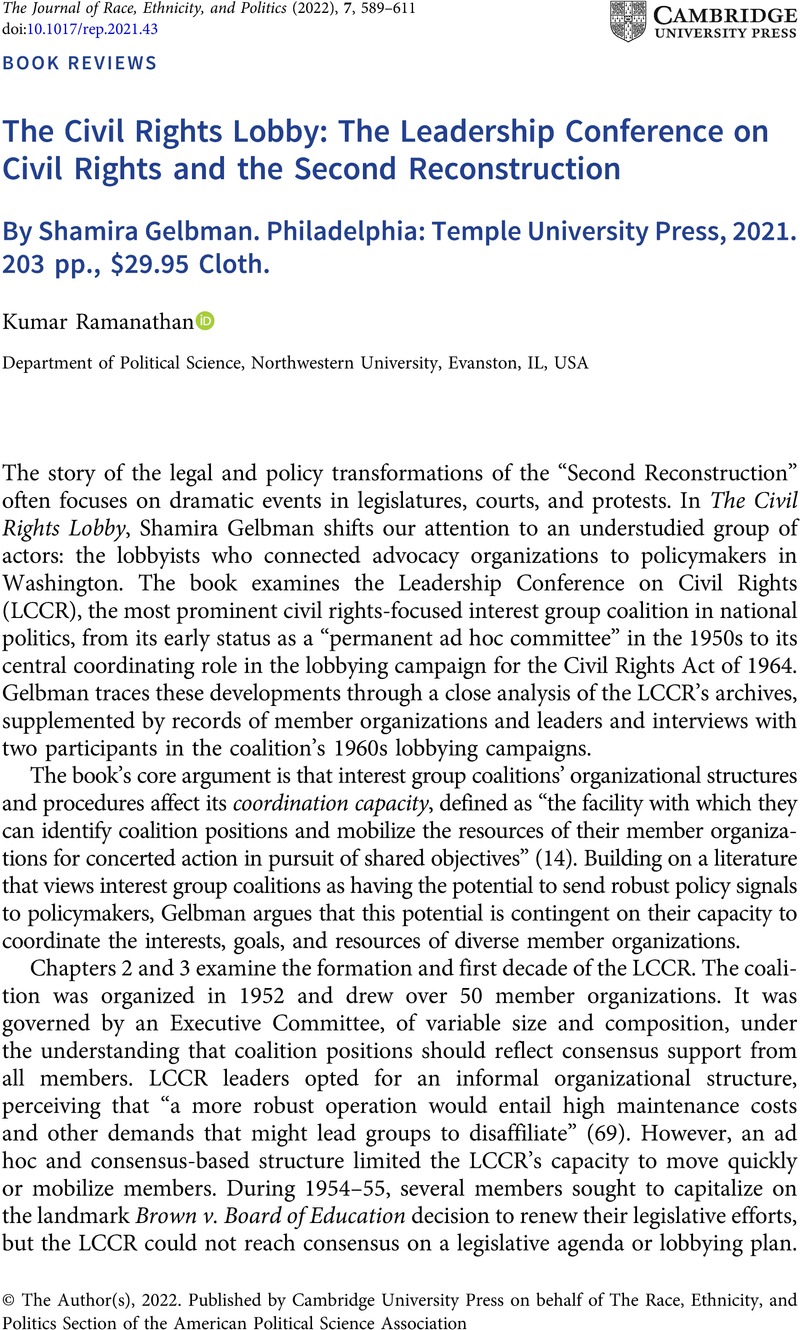The story of the legal and policy transformations of the “Second Reconstruction” often focuses on dramatic events in legislatures, courts, and protests. In The Civil Rights Lobby, Shamira Gelbman shifts our attention to an understudied group of actors: the lobbyists who connected advocacy organizations to policymakers in Washington. The book examines the Leadership Conference on Civil Rights (LCCR), the most prominent civil rights-focused interest group coalition in national politics, from its early status as a “permanent ad hoc committee” in the 1950s to its central coordinating role in the lobbying campaign for the Civil Rights Act of 1964. Gelbman traces these developments through a close analysis of the LCCR’s archives, supplemented by records of member organizations and leaders and interviews with two participants in the coalition’s 1960s lobbying campaigns.
The book’s core argument is that interest group coalitions’ organizational structures and procedures affect its coordination capacity, defined as “the facility with which they can identify coalition positions and mobilize the resources of their member organizations for concerted action in pursuit of shared objectives” (14). Building on a literature that views interest group coalitions as having the potential to send robust policy signals to policymakers, Gelbman argues that this potential is contingent on their capacity to coordinate the interests, goals, and resources of diverse member organizations.
Chapters 2 and 3 examine the formation and first decade of the LCCR. The coalition was organized in 1952 and drew over 50 member organizations. It was governed by an Executive Committee, of variable size and composition, under the understanding that coalition positions should reflect consensus support from all members. LCCR leaders opted for an informal organizational structure, perceiving that “a more robust operation would entail high maintenance costs and other demands that might lead groups to disaffiliate” (69). However, an ad hoc and consensus-based structure limited the LCCR’s capacity to move quickly or mobilize members. During 1954–55, several members sought to capitalize on the landmark Brown v. Board of Education decision to renew their legislative efforts, but the LCCR could not reach consensus on a legislative agenda or lobbying plan. When the Eisenhower administration proposed an omnibus civil rights bill in 1956, the LCCR encouraged members to support a strong version of the bill. An informal committee of active Washington-based lobbyists emerged, serving as a venue for collaboration. These lobbyists worked to collect endorsements from member organizations during the legislative process, but often struggled to receive timely responses. Ultimately, a narrow and weakened bill was passed as the Civil Rights Act of 1957.
The LCCR transformed dramatically in 1963, as Gelbman explains in chapter 4. That year, when the Kennedy administration proposed a new omnibus bill, the LCCR took on the role of coordinating civil rights groups’ lobbying efforts. Notably, LCCR leaders agreed that “oversight of the protest and lobbying campaigns should be kept separate” to facilitate dealing with recalcitrant legislators (78). Several organizational changes followed: the opening of a permanent Washington office, the hiring of a dedicated staff, and regular meetings for Washington representatives of all member organizations. In these meetings, the meaning of “consensus” shifted from an implicit veto for each member organization to support from all representatives in attendance. Armed with new organizational capacity, the LCCR published a regular newsletter stating coalition positions and calls-to-action, coordinated visits from delegations of activists to pressure their state’s representatives, and organized teams of observers to corral legislators on the floor of Congress. This “unprecedented degree of coordination” enabled the LCCR to pursue strengthening amendments to the original bill and to pressure legislators to vote in alignment with their positions (100).
The passage of the Civil Rights Act of 1964 marked an apex of policy success and spurred dozens of new members to join the LCCR. As Gelbman documents in chapter 5, however, new challenges quickly followed including “mounting issue complexity, interorganizational conflict, and oppositional backlash,” which prompted the adoption of new by-laws in 1967 (129). These by-laws—which stated shared principles, created a National Board with ultimate decision-making authority, defined the roles of permanent staff and committees, and formalized decision-making rules—marked a final departure from the coalition’s former ad hoc approach.
The Civil Rights Lobby makes a convincing case for focusing on organizational structure and coordination capacity in the study of interest group coalitions. It also offers valuable contributions for scholars of racial politics in the United States. Foremost among these is a challenge to the notion that the civil rights movement moved “from protest to politics” after the mid-1960s. Gelbman’s account makes clear that advocates pursued both from at least the 1940s, making strategic decisions about balancing insider and outsider strategies. Another valuable contribution, albeit one implicit in the text, is that the book offers a detailed case study of how marginalized groups can exercise power in quasi-democratic political institutions. The work of the LCCR is a powerful reminder that issues of interest group organization and coordination have significant implications for representation in a racially stratified society.
One lingering question is why the 1963–64 legislative campaign invited LCCR leaders to undertake such a dramatic organizational transformation. Part of the story, accounted for here, is surely that advocates learned from the challenges of earlier lobbying campaigns. Future scholarship might also explore the possible role of party politics: the proposal of an omnibus bill by a Democratic president in 1963 (compared to a Republican president in 1956) may have invoked more robust relationships between advocates and northern Democratic politicians, given that party realignment on race had been underway for two decades.
In addition to its insightful scholarly contributions, this concise and readable text would fit well in the classroom. It is well-suited to undergraduate courses where instructors seek to prompt discussion on lobbying, advocacy, and the representation of marginalized groups in U.S. politics. In threading together theoretical questions with a substantively important case study, it would also be a valuable entry in graduate syllabi on interest groups, American political development, and racial and ethnic politics.



